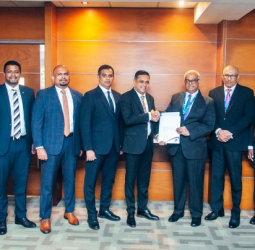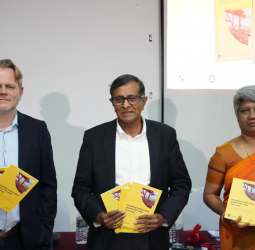
U.S. Soybean Export Council (USSEC) director of sustainability Abby Rinne (left) and regional director for South Asia and Sub-Sharan Africa, Kevin Roepke
Sri Lanka is one of the major importers of U.S. Soybean meal in South Asia and this is likely to continue while other countries in the region will also see an upward trend with shifts in demand for protein-based diets, highlighted Soy Connext summit held on 19 – 21 August in San Francisco, organized by the U.S. Soybean Export Council (USSEC) where a trade team from the country attended.
Sri Lanka requires somewhere between 210,000-240,000 MT of soybean meal in animal feed production in poultry which is the leading livestock industry in the country supplying animal proteins to the nation, and this figure is significantly growing every year according to insights from USSEC.
The U.S. soybean meal imports to Sri Lanka were estimated at USD 101 million in 2023. The textured soy requirement is equal to about 12,000 metric tons (MT) per year. The major non-genetically modified organism (GMO) soyfood product in Sri Lanka is soy nuggets.
With consumer demand for protein taking a huge leap forward every year globally, U. S. Soy plays a crucial role as a leading exporter to many parts of the world in addition to their strong domestic markets. Currently, nearly 60 percent of U.S. Soy products are exported. U.S. farmers are expected to produce 4.6 billion bushels of soybeans for the 2024/25 crop and supply estimates up 11 percent over last year, according to USDA.
While soybeans are sold as a commodity oilseed, research continues to show that soy from the U.S. is a premium product that increases operational efficiencies for livestock farms, feed mills, and oil crushers; introduces better flavor profiles in the soy foods sector, and exemplifies on-farm stewardship and conservation efforts, giving it the lowest carbon footprint.
USSEC Director of Sustainability, Abby Rinne, said ‘‘U.S. Soy is different from soy in other regions for several different factors, primarily with farmers having focused on sustainability for over a century. From the times of the Great Depression, the industry has looked at soil conservation measures and the development of agencies by the United States Department of Agriculture (USDA) to focus on working with landowners on soil conservation has had a significant impact.’’
Consumers in Sri Lanka are increasingly shifting towards choosing sustainable products. U.S. Soy enjoys more than 70 percent market share in the country, with the industry showing a strong preference based on the essential amino acid profile, higher digestibility, lower fiber and reliable supply chain that U.S. Soy has.
In July last year, a leading local poultry producer, New Anthoney’s Farms adopted the “Fed with Sustainable U.S. Soy’ label on their products, making them the first in the entire South Asian and Sub-Saharan Africa region. Ten other producers followed suit and signed licensing agreements.
‘‘Despite its smaller industry size compared to its neighboring countries, Sri Lanka’s poultry and livestock industry has continued to uphold and increase its quality, efficiency, and capabilities, with significant investments and efforts towards adopting sustainability across its entire operations and supply chain,’’ said USSEC Regional Director for South Asia and Sub-Sharan Africa, Kevin Roepke
This year’s Soy Connext recognized a few of the companies including Sri Lanka’s New Anthoney’s Group and Happy Hen (Switz Lanka) for using the Sustainable U.S. Soy and the ‘Fed with U.S Sustainable Soy’ label, which are used by 120 companies in 18 different countries and across over 1,000 products. Another new addition is that international customers of U.S. Soy can now request the inclusion of their soy purchase’s carbon footprint on their SSAP certificate.



 Thishila Mewan
Thishila Mewan



